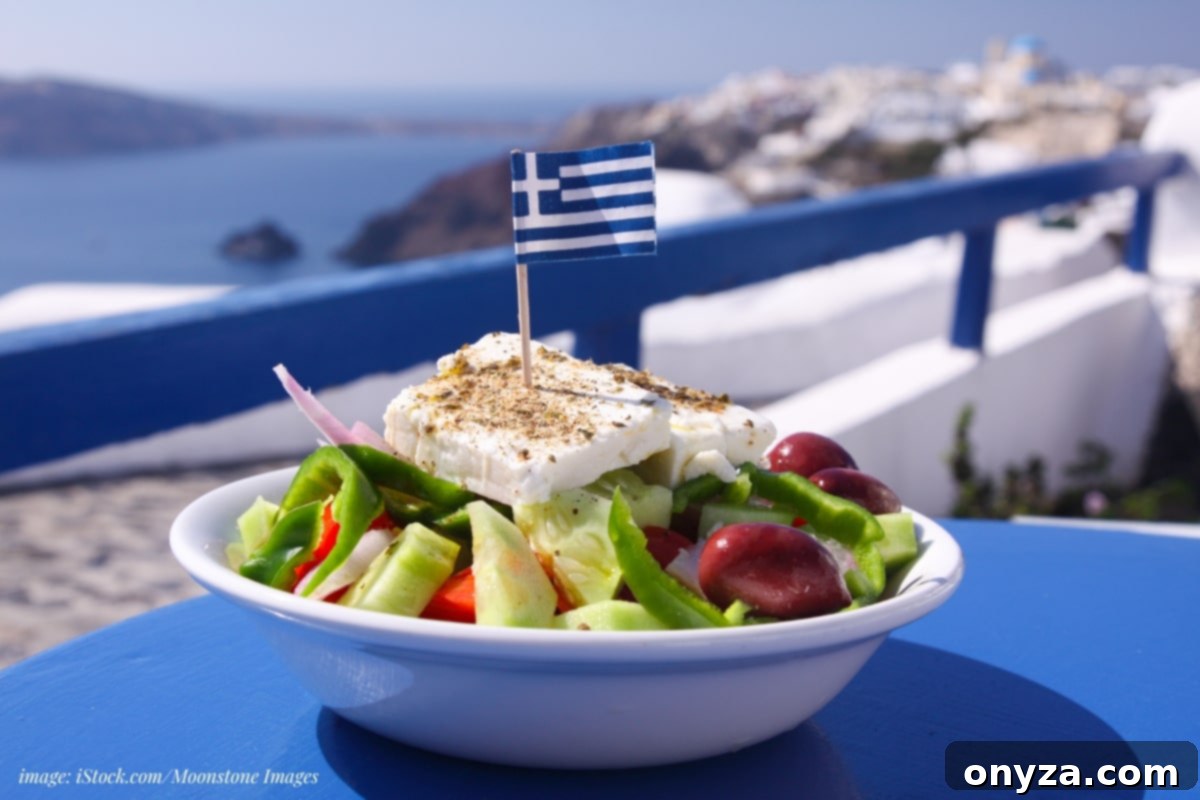The Ultimate Guide to Feta Cheese: History, How to Buy, and Culinary Inspiration
Whether you’re a newcomer to the vibrant world of Feta cheese or a seasoned connoisseur, this comprehensive guide is designed for you. Delve into the rich history of one of the world’s most ancient and beloved cheeses, uncover expert tips for selecting the finest Feta, and discover a wealth of inspiration for incorporating this versatile ingredient into your home cooking. Join us in celebrating Feta, a true culinary marvel!

In This Essential Guide:
- What is Feta Cheese: Origin, Characteristics, and Varieties
- Expert Tips for Shopping and Storing Feta Cheese
- Culinary Inspiration: Creative Ways to Enjoy Feta
- The Nutritional Profile and Health Benefits of Feta
What is Feta Cheese: Origin, Characteristics, and Varieties
Feta is a distinctive white, brined cheese, traditionally crafted from sheep’s milk or a blend of sheep’s and goat’s milk. Revered as one of the oldest and most globally recognized cheese styles, its roots stretch back to antiquity. Evidence of an early Feta-like cheese production is famously documented in Homer’s Odyssey, highlighting its enduring legacy and deep connection to ancient Mediterranean cultures. This ancient heritage underscores Feta’s role not just as a food, but as a staple embedded in centuries of tradition.
Authentic Feta offers a complex flavor profile: salty, tangy, and often with a slightly peppery or herbaceous note that can vary subtlely depending on its origin and aging process. Its texture is notably firm yet creamy, making it ideally suited for crumbling over dishes. The specific characteristics – from its aroma to its mouthfeel – are influenced by several factors: the type and ratio of milk used, the environment in which it ages, and the duration of the aging period.
Most Feta undergoes an aging process ranging from 2 to 12 months, typically in barrels, tins, or baskets. Barrel-aged Feta, often brined for a longer duration, develops a sharper, more intensely complex flavor, deepening its characteristic tang and saltiness. In contrast, Feta aged in baskets or tins usually has a shorter maturation period, resulting in a generally milder, lighter flavor profile. These subtle differences in production contribute to the rich tapestry of Feta varieties available today, each offering a unique gastronomic experience.

Feta in the European Union: A Protected Greek Product (PDO)
In a landmark decision in 2002, the European Union officially recognized Feta as a **Protected Designation of Origin (PDO)** product, exclusively associating it with Greece. This designation is a crucial legal framework designed to uphold the quality standards of traditional, regional foods and safeguard their authenticity and integrity within the marketplace. For consumers, this means that any cheese labeled “Feta” sold within the EU must adhere to stringent production requirements, ensuring its origin and traditional craftsmanship.
PDO Feta is legally mandated to contain at least 70% sheep’s milk, with the option of including up to 30% goat’s milk. Furthermore, this milk must originate from specific, designated regions within Greece, including Peloponnese, Epirus, Central Greece, Macedonia, Thessaly, Thrace, and the islands of Lesvos and Cephalonia. This strict geographical and compositional requirement ensures that consumers receive a product that truly embodies the heritage and unique qualities of Greek Feta, preserving centuries-old cheesemaking traditions.

Global Variations: “Feta” Outside of Greece
You might be wondering, “But wait… I’ve seen cheeses labeled ‘Feta’ from other countries!” Indeed, this is a common observation, particularly in countries like the United States. Herein lies a fascinating aspect of global food trade and cultural heritage: PDO regulations, while powerful within the EU, do not automatically extend to all countries outside its jurisdiction.
While some nations have entered into agreements with the EU to honor PDO designations, others have not. Despite ongoing efforts to broaden these restrictions to globally produced and sold PDO products, such initiatives have encountered considerable resistance. This global dynamic stems from a long history: Feta-style cheeses, with their own regional variations, have been produced outside Greece for hundreds, if not thousands, of years. A notable historical conflict between Greece and Denmark over Danish cow’s milk “Feta” even played a pivotal role in the initial establishment of the PDO designation.
The bottom line for consumers is this: it is generally not permissible to market a non-Greek Feta-style cheese as “Feta” within the European Union and in countries that have formally agreed to uphold PDO regulations. In these regions, you will often find such cheeses labeled with descriptive terms like “white cheese” or “brined cheese.” However, in markets like the United States, the term “Feta” is currently considered fair game, leading to a wider array of products under the Feta name, often with distinct characteristics from their Greek counterparts.

Common Non-Greek “Feta” Styles: A Comparative Look
Beyond the borders of Greece, numerous “Feta-style” cheeses have developed, each reflecting the unique dairy traditions and local palates of their respective regions. These varieties offer distinct flavors and textures, providing a diverse range of options for cheese lovers:
- Bulgarian Feta (Sirene): Often referred to as “Sirene,” this Feta-style cheese is incredibly popular in Eastern Europe. It can be made from sheep’s milk, cow’s milk, goat’s milk, or a combination thereof, resulting in a broader spectrum of flavors. Generally, Bulgarian Feta is known for being saltier and tangier than its Greek counterpart, with some describing its flavor as having a pleasant lemony zest. Its texture is typically firm, yet less crumbly than traditional Greek Feta, often lending itself to slicing rather than just crumbling.
- French Feta (Valbreso): Produced primarily in the southwest region of France, French Feta is typically made from 100% Lacaune sheep’s milk, the same milk prized for crafting the renowned Roquefort cheese. This variety is celebrated for its milder flavor profile, being notably less salty and possessing a creamier texture than both Greek and Bulgarian Fetas. It is frequently marketed under the “Valbreso” label, offering a delicate and approachable alternative for those seeking a less intense brined cheese.
- Israeli Feta (Pastures of Eden): Typically crafted from sheep’s milk and usually brined for approximately one month, Israeli Feta offers a much mellower and less salty taste compared to traditional Greek Feta. Its texture is distinctively suited more for slicing than for crumbling, making it a versatile ingredient for sandwiches or cheese platters. The “Pastures of Eden” brand is a common label under which this style of Feta can be found, known for its gentle flavor and firm consistency.
- American Feta: Domestic Feta produced in the United States is most frequently made with cow’s milk, a departure from the traditional sheep’s and goat’s milk. Generally, American Feta tends to be milder in flavor, often drier, and more crumbly than imported varieties. While it might lack the profound tang and complexity of a PDO Greek Feta, it serves as an accessible and often more affordable option for everyday culinary uses, particularly for those who prefer a less assertive cheese.

Expert Tips for Shopping and Storing Feta Cheese
Finding the perfect Feta, whether it’s an authentic Greek import or a high-quality Feta-style cheese, can elevate your culinary creations. You’ll typically find these cheeses in the specialty cheese section of your local grocery store, at international markets, or in dedicated gourmet cheese shops. Here are some invaluable tips to guide your purchase and ensure you bring home the best Feta:
- Seeking Authentic Greek Feta? Look for the PDO Stamp. For an uncompromised, traditional Greek Feta experience, always check the packaging for the distinctive red and yellow PDO (Protected Designation of Origin) mark. This stamp is your guarantee that the cheese meets the strict Greek and EU standards for origin and production. If you’re purchasing Feta from a cheese counter where it’s not pre-packaged, don’t hesitate to ask your cheesemonger to show you the PDO stamp on the original wholesale label or tub. Renowned Greek brands frequently imported to countries like the United States, such as Real Greek and Dodoni, are excellent choices known for their quality and authenticity.
- Always Opt for Feta Stored in Brine. Feta cheese, by its very nature, is a brined cheese, and it tends to dry out remarkably quickly once exposed to air. To preserve its characteristic firm yet creamy texture and its quintessential tangy, salty flavor, it is crucial to purchase Feta that is submerged in its original brine (a solution of salt and water). Whether you’re selecting a pre-packaged container from the dairy case or having it cut at a serviced cheese counter, ensure it comes immersed in this protective liquid. A skilled cheesemonger will package your Feta in brine to maintain its freshness until you get it home.
- Bypass Pre-Crumbled Feta Whenever Possible. While the convenience of pre-crumbled Feta might be appealing, it often comes at the cost of quality. In my experience, crumbled Feta that has been stored in brine tends to absorb an excessive amount of moisture, leading to a mushy, degraded texture and a diluted flavor. For the ultimate taste and textural integrity, it is highly recommended to purchase Feta in a solid block and crumble it yourself just before use. The only exception might be if you are certain the pre-crumbled Feta is exceptionally fresh and you intend to use it immediately, for instance, the same day it was prepared.
Proper Storage of Feta at Home
Once you’ve brought your Feta home, proper storage is key to maintaining its quality. Keep block Feta submerged in its brine in an airtight container in the refrigerator. If the Feta runs out of brine, you can create a simple replacement by dissolving 1 teaspoon of salt in 1 cup of cold water. This homemade brine will help keep the Feta fresh and prevent it from drying out for several weeks. Avoid freezing Feta, as it can significantly alter its texture, making it crumbly and less desirable.
The Nutritional Profile and Health Benefits of Feta
Beyond its incredible taste and versatility, Feta cheese also offers a range of nutritional benefits. It is a good source of protein, essential for muscle repair and growth, and is rich in calcium, which is vital for strong bones and teeth. Feta also provides significant amounts of B vitamins, particularly B12, crucial for nerve function and red blood cell production. While it contains sodium due to the brining process, when consumed in moderation as part of a balanced diet, Feta can be a delicious and healthful addition to your meals. It’s also often easier to digest for those with lactose sensitivity compared to some other cheeses, especially if made from sheep’s or goat’s milk.
Culinary Inspiration: Creative Ways to Enjoy Feta
Feta cheese is a remarkably versatile ingredient, capable of transforming simple dishes into vibrant culinary experiences. Its salty, tangy profile and unique texture make it a favorite across a myriad of cuisines. Here are some delicious ideas to inspire your cooking with Feta:

Chickpea Salad with Lemon Vinaigrette and Feta
This vibrant Chickpea and Feta Salad is a fantastic choice for a light lunch, especially when served alongside warm flatbread. It also makes an excellent side dish, complementing an array of grilled meats and seafood beautifully. Its fresh flavors and satisfying texture are sure to please.
View Recipe

Leftover Lamb Pita Board
Transform your delicious leftover holiday lamb roast into an inviting and interactive Pita Board! This casual, self-serve presentation allows everyone to customize their pita with their favorite add-ins, including crumbled Feta, for a fun and memorable meal.
View Recipe

Mediterranean Pearled Couscous Salad
This delightful Pearled Couscous Salad, brimming with Mediterranean flavors, makes for a bright and fresh side dish or a satisfying meatless main. It’s perfect for a quick weeknight dinner or an elegant addition to summer entertaining, beautifully complemented by the salty tang of Feta.
View Recipe
Beyond Salads and Pitas: More Ways to Enjoy Feta
- Roasted Vegetables: Toss cubed Feta with roasted vegetables like zucchini, bell peppers, eggplant, and cherry tomatoes. The Feta softens and caramelizes slightly, adding a creamy, salty counterpoint to the sweet veggies.
- Baked Feta Appetizers: A block of Feta baked with olive oil, herbs (like oregano or thyme), and chili flakes until warm and slightly gooey is an incredible dip for crusty bread.
- Eggs and Breakfast Dishes: Crumble Feta into scrambled eggs, omelets, or frittatas for a savory kick. It also pairs wonderfully with spinach or sun-dried tomatoes in a breakfast wrap.
- Pasta Dishes: Stir Feta into warm pasta with fresh tomatoes, basil, and a drizzle of olive oil for a simple yet flavorful meal. It melts just enough to create a light, creamy sauce.
- Pizzas and Flatbreads: Use Feta as a topping on homemade pizzas or flatbreads, especially those with Mediterranean-inspired ingredients like olives, red onion, and spinach.
- Dips and Spreads: Blend Feta with Greek yogurt, olive oil, and herbs to create a creamy, tangy dip for crudités or pita chips.
- Stuffed Peppers or Mushrooms: Mix Feta with rice, herbs, and other vegetables to create a savory stuffing for bell peppers or large mushrooms, then bake until tender.
Eager for more insights into the world of cheese? Don’t miss our extensive collection of Cheese Guides for deep dives into various delightful dairy creations!
